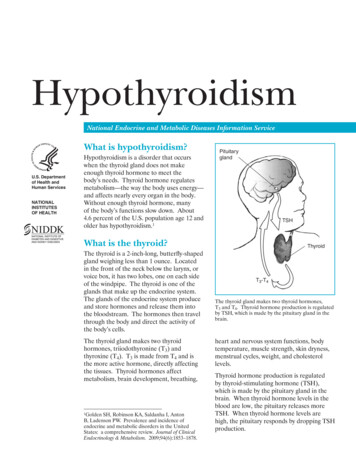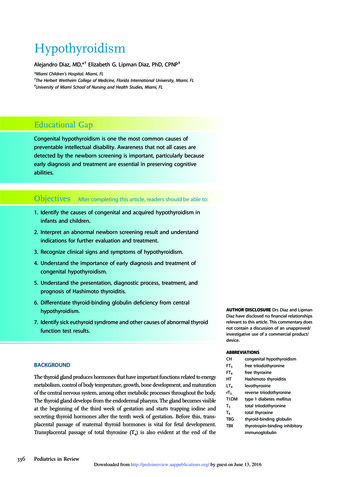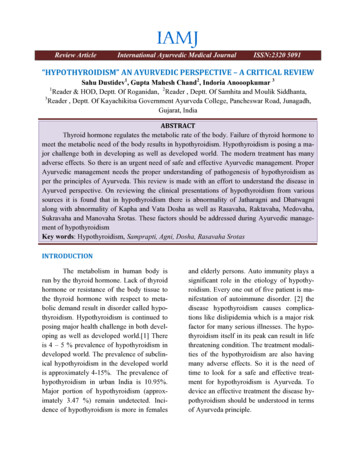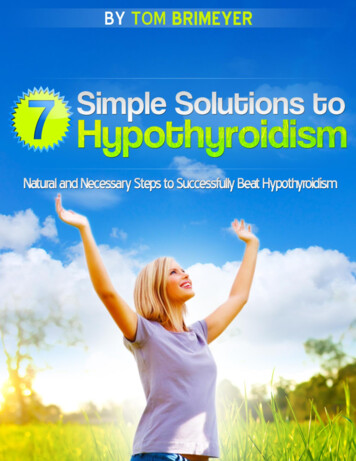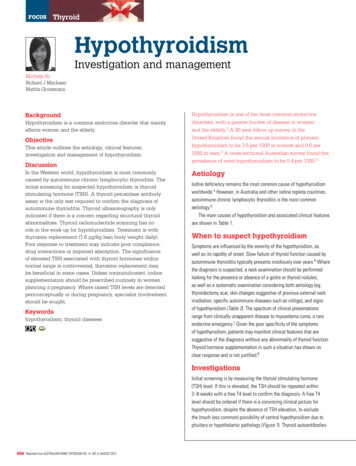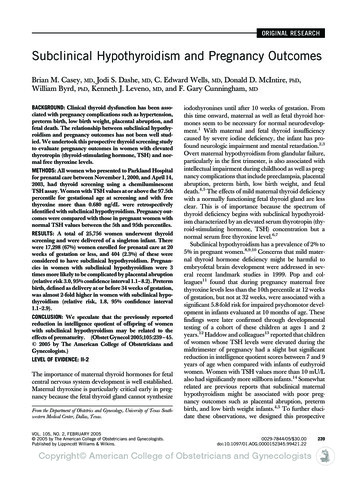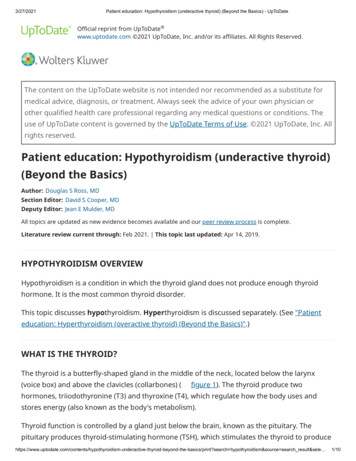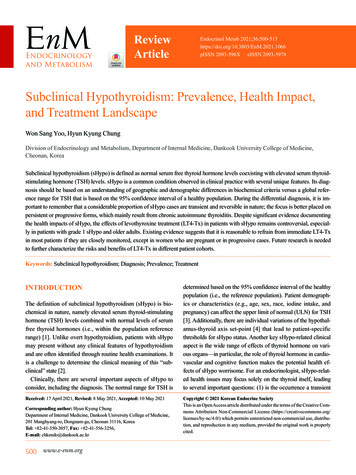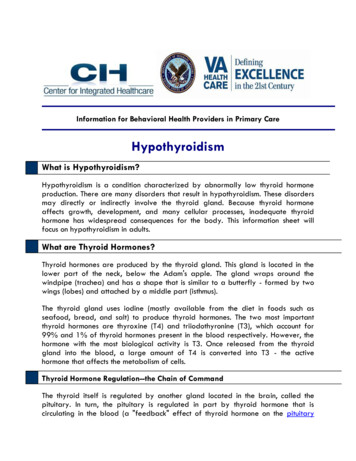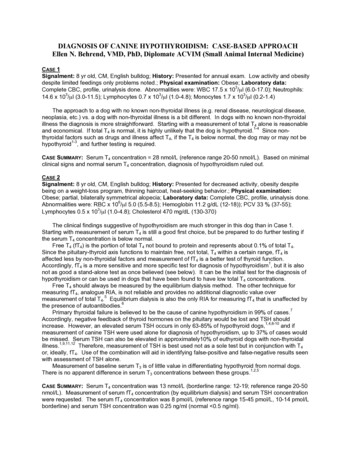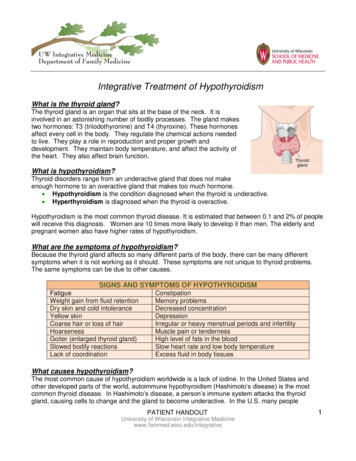
Transcription
Integrative Treatment of HypothyroidismWhat is the thyroid gland?The thyroid gland is an organ that sits at the base of the neck. It isinvolved in an astonishing number of bodily processes. The gland makestwo hormones: T3 (triiodothyronine) and T4 (thyroxine). These hormonesaffect every cell in the body. They regulate the chemical actions neededto live. They play a role in reproduction and proper growth anddevelopment. They maintain body temperature, and affect the activity ofthe heart. They also affect brain function.What is hypothyroidism?Thyroid disorders range from an underactive gland that does not makeenough hormone to an overactive gland that makes too much hormone.Hypothyroidism is the condition diagnosed when the thyroid is underactive.Hyperthyroidism is diagnosed when the thyroid is overactive.Hypothyroidism is the most common thyroid disease. It is estimated that between 0.1 and 2% of peoplewill receive this diagnosis. Women are 10 times more likely to develop it than men. The elderly andpregnant women also have higher rates of hypothyroidism.What are the symptoms of hypothyroidism?Because the thyroid gland affects so many different parts of the body, there can be many differentsymptoms when it is not working as it should. These symptoms are not unique to thyroid problems.The same symptoms can be due to other causes.SIGNS AND SYMPTOMS OF HYPOTHYROIDISMFatigueWeight gain from fluid retentionDry skin and cold intoleranceYellow skinCoarse hair or loss of hairHoarsenessGoiter (enlarged thyroid gland)Slowed bodily reactionsLack of coordinationConstipationMemory problemsDecreased concentrationDepressionIrregular or heavy menstrual periods and infertilityMuscle pain or tendernessHigh level of fats in the bloodSlow heart rate and low body temperatureExcess fluid in body tissuesWhat causes hypothyroidism?The most common cause of hypothyroidism worldwide is a lack of iodine. In the United States andother developed parts of the world, autoimmune hypothyroidism (Hashimoto’s disease) is the mostcommon thyroid disease. In Hashimoto’s disease, a person’s immune system attacks the thyroidgland, causing cells to change and the gland to become underactive. In the U.S. many peoplePATIENT HANDOUTUniversity of Wisconsin Integrative Medicinewww.fammed.wisc.edu/integrative1
Integrative Treatment of Hypothyroidismwho have hyperthyroidism will eventually be diagnosed with the opposite condition—hypothyroidism. This is because an overactive thyroid gland can “burnout” or because medicaltreatment for hyperthyroidism eventually results in the opposite condition.CAUSES OF HYPOTHYROIDISMToo little or too much iodine in the dietChronic autoimmune thyroiditis(Hashimoto’s thyroiditis)Thyroid surgeryDrugs used now or in the pastAmiodarone (used to controlproblems with heart rhythm )The dye containing iodine that isused in x-ray proceduresLithium (used to treat bipolardisorder)Severe illness such as infection ortraumaInflammation of the thyroid gland following childbirthA birth defect resulting in the thyroid gland beingabsent or abnormalRadiation to the neckDiseases that affect one or more organs such asTuberculosis (a contagious disease affectingthe lungs)Sarcoidosis (a disease involving manyorgans which causes the growth of lumpsresembling little tumors)A problem in the pituitary gland, where TSH is madeA problem in the hypothalamus, the part of the brainthat controls many body processesHow is hypothyroidism diagnosed?A clinician will diagnose hypothyroidism based on:your symptomsa physical examinationyour medical history (e.g., medications, previous thyroid surgery or radiation to your neck)your family history (e.g., if a family member has had thyroid disease)and one or more blood testso Thyroid Stimulating Hormone (TSH) test. This test measures the amount of TSHin your blood. TSH is made by the pituitary gland. (The pituitary gland is locatedat the base of the brain and makes a number of different hormones). TSHdetermines how much T3 and T4 hormones the thyroid should make. A high levelof TSH means the thyroid gland is not making enough T3 and T4 hormones.o T4 and T3 test. For some causes of hypothyroidism, a TSH test alone will not beenough to detect disease. T4 and T3 tests measure the amount of thesehormones in your blood.There has been some debate in recent years over the diagnosis of hypothyroidism. Somepatients seem to have symptoms even though their TSH and T4 tests are in the normal range.To address this issue, the normal ranges for TSH have been changed in the past decade. Also anew category of disease called subclinical hypothyroidism has been created. This diagnosis ismade when a patient has normal blood tests yet seems to have a thyroid gland that is notfunctioning correctly. Integrative medicine clinicians will look at each patient as an individual.They will base their treatment recommendations on the symptoms you report as well as theresults of your thyroid tests.PATIENT HANDOUTUniversity of Wisconsin Integrative Medicinewww.fammed.wisc.edu/integrative2
Integrative Treatment of HypothyroidismHow is hypothyroidism treated?The first step in treatment is to eliminate or relieve known or suspected causes of the disease.Your clinician will be considering your medications, diet, and other possible illnesses. Usuallytreatment can begin before the exact cause is known. Typically the goal is to have lab tests andmeasurements such as your body temperature return to normal. The normal range for TSH is0.4-4.0 micro units/ml. Your symptoms may best improve if your TSH is in the range of 0.5-3.0micro units/ml with treatment. Successfully treating this disease involves improving othersymptoms as well. If you are being treated for hypothyroidism, talk to your clinician about anysymptoms you think may be related, even if your TSH and T4 tests are in the normal range.Adjusting your treatment may help you feel better. If left untreated over time, hypothyroidism canlead to serious health problems and become life-threatening.An integrative approach to treatment includes: 1) nutrition and supplements, 2) botanicals, 3)prescription drugs, and perhaps 4) some other complementary approaches.1. Nutrition and SupplementsIodine. Iodine is a mineral that the thyroid gland needs in order to work properly andmake T3 and T4 hormones.A lack of iodine is a major cause of hypothyroidism worldwide. This usually occurs incountries that are poor and land-locked, where people get less than 50 mcg of iodine perday in their diets. Programs that add iodine to salt have corrected the problem in manyparts of the world. It is rare for people in the U.S. or other developed nations to be gettingtoo little iodine.The main way a person gets iodine is by eating iodized salt, saltwater fishand sea vegetables. The Recommended Dietary Allowance (RDA) of iodineis 150 mcg per day for adults. You get this amount by eating one halfteaspoon of iodized salt. The average American eats more than twice thisamount each day. However, if you are on a diet that strictly reduces salt, youmay not be getting enough iodine. A healthy way to get more iodine is to eatsea vegetables. You can find sea vegetables at grocery stores that carryhealth food or have an Asian food section as well as at Japaneserestaurants.The most iodine an adult should get is 1,100 mcg per day. You can get too much iodineif you eat large amounts of seafood, iodine supplements, or sea vegetables (see sectionon Botanicals on pages 4-5.) Ironically, getting too much iodine can also causehypothyroidism. This is temporary and clears up when a person is no longer getting suchhigh doses of iodine.Blood and urine tests are sometimes helpful in identifying whether someone is gettingenough iodine. It is not clear if these tests tell the whole story. It is possible that they arenot always reliable.PATIENT HANDOUTUniversity of Wisconsin Integrative Medicinewww.fammed.wisc.edu/integrative3
Integrative Treatment of HypothyroidismSelenium. Selenium is another mineral the body needs in order for the thyroid gland towork properly. Selenium helps change T4 into a form your body can use. Getting moreselenium, if you are lacking it, may improve how your thyroid gland works.A lack of selenium is uncommon. People with severe intestinal diseases (such as severeCrohn’s disease) are at risk for developing a low selenium level. A low level of seleniumin the body may not cause symptoms but may lead to other diseases, such ashypothyroidism or heart problems.It is unclear to what extent selenium supplements will help if you are already gettingenough selenium. Selenium supplements might be helpful for people whosehypothyroidism is caused by autoimmune thyroiditis (Hashimoto’s Disease). It has alsobeen found to improve well-being and mood for people with this cause of the disease.Be careful in taking selenium supplements if you are also low in iodine. Selenium cancause your thyroid function to be worse if you are not getting enough iodine in your diet.You can take supplements of both selenium and iodine at the same time if you are lackingboth. Work with your clinician to do this safely. Selenium can be harmful. The RDA forselenium is 55 mcg per day. The most an adult should take is 400 mcg per day. Onerelatively safe way to get this amount is by eating 3-4 Brazil nuts each day.Other nutrients: Vitamin A, Iron and Zinc. Many other vitamins and nutrients helpdetermine how the thyroid gland works. Vitamin A, iron and zinc are three of the mostimportant. Work with your clinician to determine if you are getting enough of them in yourdiet. If not, you might try taking supplements. Recommended daily doses for low thyroidfunction for adults are as follows:o Zinc 10-40 mg/day.o Iron 325 mg of ferrous sulfate or ferrous gluconateo Vitamin A 800-3,000 mcg/day.L-Tyrosine. Thyroxin (T4) is one of the hormones the thyroid gland makes. T4 is madefrom tyrosine, which is a non-essential amino acid, a building block of protein. L-tyrosinesupplements are commonly used to support the thyroid gland. L-tyrosine has been shownto improve alertness and ability to function in people who did not get enough sleep. Thismeans that it could possibly help improve the symptoms of hypothyroidism, although thisis not known for sure. Regardless, L-tyrosine is generally safe. If you have beendiagnosed with hypothyroidism, you may want to consider taking this supplement. Thetypical daily dose is 500 mg 2-3 times daily before meals. It is a good idea to work withyour clinician to make certain you take the correct dose.2. Botanicals and Sea VegetablesSea Vegetables. Sea vegetables or seaweeds contain different amounts of iodinedepending on the species, where they grew, and how they are prepared. Considerincluding them in your diet if you or your clinician suspect that you are getting too littleiodine. Do not eat them as much or at all if it appears that you are getting too muchiodine.PATIENT HANDOUTUniversity of Wisconsin Integrative Medicinewww.fammed.wisc.edu/integrative4
Integrative Treatment of HypothyroidismCOMPARISON OF SEA VEGETABLES TO OTHER SOURCES OF IODINE18,19FoodMinimum Amount Needed toMaximum Amount forMeet Daily Intake Requirement* Daily Intake Requirement*Sea vegetablesKelp9 mg 0.0003 oz/day70 mg 0.0025 oz/dayNori9 g 0.3 oz/day69 g 2.4 oz/dayDulse2 g 0.07 oz/day15 g 0.5 oz/dayOther foodsIodized Salt2 g or 1/3 tsp/day14g or 2.5 tsp/dayCod4.5 oz/day ( 1.5 servings)33 oz/dayCow’s Milk3 cups/day20 cups/dayPotato (with peel)2.5 medium size18 medium size*These amounts are estimates. Actual content of foods vary considerably based upon growingconditions, storage and preparation.Guggulu (Commiphora wightii). Guggulu (also known as or guggal, or guggul lipid) is asticky substance that is found in a small tree used in Ayurvedic medicine. (Ayurvedicmedicine is an ancient system of medicine from India.) The high fiber content of gugguluis used as a possible way to lower cholesterol. A part of guggulu called guggulsterone hasbeen found to have good effects on the thyroid, but further research is needed.Plant foods. There are many foods that may contribute to the thyroid not working well.Unfortunately, many of these are otherwise very healthy foods. They include the brassicagenus of vegetables (e.g., broccoli, cabbage, cauliflower, turnip), soy, cassava (the root iseaten, and it is used to make tapioca) and millet (a grain). These negative effects onlyseem to occur for people who are low on iodine. So, probably the best way to avoid anynegative effects of these generally healthy foods is to eat enough foods containing iodine.Cooking these foods may help to prevent negative effects on the thyroid as well.3. Prescription medicationsCan I avoid taking prescription medications? Clinicians prescribe medication for mostpatients with hypothyroidism. Patients often ask if there is a way to avoid taking aprescription drug. This may be possible if you are diagnosed with subclinical hypothyroidism.This is when the TSH is slightly higher than normal, but the T3 and T4 are in the normalrange. Subclinical hypothyroidism could possibly be reversible. Once you start taking thyroidmedication, however, you will probably have to take it forever. You would not know if thecondition could have been reversed. Talk with your clinician if you are diagnosed withsubclinical hypothyroidism and want to try a non-drug approach first. You will find a list ofsuggested supplements and vitamins for this purpose on the next page. Your clinician shouldwork closely with you to monitor the success of this approach.PATIENT HANDOUTUniversity of Wisconsin Integrative Medicinewww.fammed.wisc.edu/integrative5
Integrative Treatment of HypothyroidismA SUGGESTED NON-DRUG APPROACH TO TRY IF YOU ARE DIAGNOSED WITHSUBCLINICAL HYPOTHYROIDISMTake all of the following by mouth each day.Iodine: 150-600 mcg (if your diet puts you at risk for too low a level)or cut back on foods containing iodine if you may be getting too muchSelenium: 50-300 mcg (about 2 brazil nuts daily)Zinc: 10-40 mgFerrous sulfate: 325 mg (65 mg of elemental iron)Vitamin A: 800-3,000 mcgL-Tyrosine: 500 mg 3 times daily before meals(Generally, a diet that consists of seafood, a handful of nuts, dark greens and multi-coloredwhole foods will include the majority of these nutrients)Keep a list of the symptoms you experience. Also see your clinician to have another TSHthyroid test in six weeks. If your symptoms and the test results remain the same, stop thesupplements. Your clinician will advise you regarding further treatment.Prescription medications for hypothyroidism include: synthetic (man-made) T4, synthetic T3,and ground pig thyroid.Synthetic T4 (Levothyroxine). Synthetic T4, with the drug name levothyroxine, is thetreatment usually prescribed for hypothyroidism. A clinician starts a patient on a dose from12.5 to 50 mcg per day. A TSH blood test done every 6-8 weeks will help to determine ifthe dose should be adjusted. Young healthy individuals might start at a dose of about 1.6mcg per kilogram of body weight per day. The highest dose prescribed is about 300 mcgper day.Synthetic T3 (Liothyronine). Synthetic T3, with the drug name liothyronine, isoccasionally used along with synthetic T4 to treat hypothyroidism. It is harder to find theright dose compared to synthetic T4.However, each person is different. Synthetic T4 alone may not be adequate to treat allpeople with hypothyroidism effectively. A number of studies have been done toinvestigate if giving synthetic T3 and T4 together would be better than giving synthetic T4alone. The studies had different results. Analyzing the results of several studies togetherinvolving 1,216 patients showed that treatment with both synthetic T3 and T4 was nobetter than synthetic T4 alone. A later study found that patients who had treatment withboth synthetic T3 and T4 reported better quality of life and well-being than those who tooksynthetic T4 alone.One possible approach is for clinicians to prescribe a combination of synthetic T3 and T4for patients whose blood tests do not return to normal after treatment with synthetic T4alone. This could be tried especially for patients whose T3 levels continue to remain at lowPATIENT HANDOUTUniversity of Wisconsin Integrative Medicinewww.fammed.wisc.edu/integrative6
Integrative Treatment of Hypothyroidismor low normal. If this is your situation, your doctor might prescribe a dose of one part T3with four parts T4.Porcine (pig) thyroid. Ground pig thyroid is an older form of thyroid hormone that is stillused by many patients. Some brand names are Armour Thyroid, NP Thyroid and NatureThyroid. Drugs made from pig thyroid contain a combination of about 80% T4 and 20%T3, which is like the natural hormones our human thyroid gland makes. Many patientsconsider this to be more natural, and they report better results with this form ofmedication. The clinician monitors treatment in the same way as synthetic T4. A review ofsymptoms and a TSH blood test done every 6-8 weeks will help to determine if the doseshould be adjusted. 1 grain (60 mg) of ground pig thyroid 100 mcg of synthetic T4. Thestarting dose is 0.5 grains in young healthy adults.What is the best way to take thyroid medication? Paying attention to the time of day andtaking thyroid medication on an empty stomach may help it work better.Time of day. In the past, patients were instructed to take thyroid medications in themorning on an empty stomach. The reasoning was that this would help preventinterference with food or other medications. However a recent study showed good bloodtest results when synthetic T4 was taken at bedtime. Based on this evidence, it isreasonable to take your thyroid medication before bed. Taking it in the morning is alsofine, especially if this helps you remember to take it.Empty stomach. Many medications, supplements and foods can interfere with how yourbody absorbs thyroid medication. For this reason, it is best to take thyroid medication onan empty stomach. Common medications and supplements that interfere with your thyroidmedication include: proton pump inhibiters, antacids, anticonvulsants, calcium and iron.4. Other Complementary Approaches to ConsiderIf you like to use complementary approaches, there are two you might consider for thyroidhealth. Both are generally safe. However, at this time, there is no strong proof that they willbe helpful.Yoga. There is a particular yoga asana (posture) that is considered to be helpful to thethyroid gland. This is Sharvangasana--the shoulder stand. This claim has not been wellresearched. This yoga posture is generally safe under the guidance of a qualified teacher.Hydrotherapy. Hydrotherapy is a general term for approaches that involve sitting or lyingin water to promote healing. Hydrotherapy has been used from ancient times to the spaswe see today. Most often, different temperatures of water are used. It is possible thatsitting in different temperatures of water could exercise and strengthen the system of thebody that controls body temperature. The thyroid gland plays a major role in controllingbody temperature. Therefore, hydrotherapy might exercise and strengthen the thyroidgland. Further research is needed.PATIENT HANDOUTUniversity of Wisconsin Integrative Medicinewww.fammed.wisc.edu/integrative7
Integrative Treatment of HypothyroidismThe information in this handout is for general education. It is not meant to be used by apatient alone. Please work with your health care practitioner to use this information inthe best way possible to promote your health.This handout was created by Charlene Luchterhand, MSSW, Integrative Medicine Program,Department of Family Medicine, University of Wisconsin-Madison School of Medicine and PublicHealth. It was adapted from a version written for clinicians by Surya Pierce MD, IntegrativeFamily Physician, Li Si Wi Nwi Clinic, Absentee Shawnee Tribal Health Programs, Norman, OK.References, if needed, can be found in the clinician version of this handout.Date Created: October 2011Notes:PATIENT HANDOUTUniversity of Wisconsin Integrative Medicinewww.fammed.wisc.edu/integrative8
What is hypothyroidism? Thyroid disorders range from an underactive gland that does not make enough hormone to an overactive gland that makes too much hormone. Hypothyroidism is the condition diagnosed when the thyroid is underactive. Hyperthyroidism is diagnosed when the thyroid is overactive. Hypothyroidism is the most common thyroid disease.
